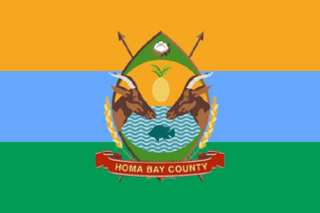
Trans-Nzoia County is a county in the former Rift Valley Province, Kenya, located between the Nzoia River and Mount Elgon, 380 km northwest of Nairobi. At its centre is the town of Kitale which is the capital and largest town. The county borders Bungoma to the west, Uasin Gishu and Kakamega to the south, Elgeyo-Marakwet to the east, West Pokot to the north and the republic of Uganda to the Northwest. Trans Nzoia covers an area of 2495.5 square kilometres.
Kakamega is a town in western Kenya lying about 30 km north of the Equator. It is the headquarters of Kakamega County that has a population of 1,867,579.

The Luhya comprise a number of Bantu ethnic groups native to western Kenya. They are divided into 20 culturally and linguistically related tribes.

After the 2013 general election, and the coming into effect of the new constitution, provinces became defunct and the country was now divided into 47 counties. Each county has its own government and therefore there is no central regional capital. Western Province became the Western region, comprising four counties: Kakamega, Bungoma, Vihiga, and Busia.

Busia District is a district in the Eastern region of Uganda.

Busia is a county in the former Western Province of Kenya. It borders Kakamega County to the east, Bungoma County to the north, Lake Victoria and Siaya County to the south and Busia District, Uganda to the west. The county has about 893,000 people and spans about 1,700 square kilometers making it one of the smallest counties in Kenya. Busia is inhabited by the Luhya tribe of Kenya and the Teso of Kenya, and small groups of the Luo. The Luhya communities include the Abakhayo, Marachi, Samia and Abanyala communities.

Bungoma County is a county in the former Western Province of Kenya. Its capital is Bungoma town. It has a population of 1,670,570 of which 812,146 are males 858,389 females as per the 2019 census and an area of 2,069 km2. It has nine constituencies, namely: Bumula, Kabuchai, Kanduyi, Kimilili, Mt. Elgon, Sirisia, Tongaren, Webuye East and Webuye West.

Kisumu County is one of 47 counties in the Republic of Kenya. Its borders follow those of the original Kisumu District, one of the former administrative districts of the former Nyanza Province in western Kenya. Its headquarters is Kisumu City which is the third largest city in Kenya after the capital Nairobi and the coastal city of Mombasa. It has a population of 1,155,574. The land area of Kisumu County totals 2085.9 km2.

Kakamega County is a county in the former Western Province of Kenya and borders Vihiga County to the South, Siaya County to the West, Bungoma and Trans Nzoia counties to the North and Nandi and Uasin Gishu counties to the East. Its capital and largest town is Kakamega. It has a population of 1,867,579 and an area of 3,033.8 km2.
Mûkûrwe'inî was a former district in Nyeri County, Kenya.
Matungu is a small town in the Western Province of Kenya. It is located in the Kakamega County.
Butere is a town in Kakamega County of the former Western Province of Kenya. It has an urban population of 4,725. Until 2010, the town was the capital of the former Butere/Mumias District.

Local authorities in Kenya are the bodies controlling local governance in urban areas in Kenya.

Homa Bay County is a county in the former Nyanza Province of Kenya. Its capital and largest town is Homa Bay. The county has a population of 1,131,950 and an area of 3,154.7 km2. Lake Victoria is a major source of livelihood for Homa Bay County. It has 40 wards, each represented by an MCA to the assembly in Homa Bay town as its headquarters.

The districts of Kenya were divided into 262 divisions (matarafa). Divisions of Kenya were further subdivided into locations. Today's counties of Kenya are based on the merging of some of the districts on this list and since the divisions are one level under the districts they are now the sub-counties. This is because Kenya recently changed its constitution and 47 Counties emerged. Here are the divisions listed below, by district :
Fort Ternan is a small town in Kericho County, Kenya, located 50 kilometres east of Kisumu and five kilometres east of Koru. It is named after Col. Trevor Ternan C.M.G.D.S.O. Fort Ternan is located at the western border of the former Rift Valley Province. Fort Ternan forms a ward of Kipkelion West Constituency and Kipsigis town council. Fort Ternan is also a location in the Chilchila division.
The Kabras, or Kabarasi, are a subtribe of the Luhya people of Kenya. They reside in Malava that is in the Kabras Division of Kakamega District, which is neighboured by the Isukha, Banyala, Tsotso, and the Tachoni. The exact origin of the Luhya people is currently disputed, but there are historians who believe that the group came from Bethlehem and migrated to their present-day location by way of the so-called Great Bantu Migration.

The Khayo is a sub tribe of the Luhya people of Kenya. They reside in Busia County, by the Kenya-Uganda border. Their Luhya neighbors are the Samia, Marachi, Wanga and Bukusu. The Bakhayo border the Bukusu on the East, the Republic of Uganda and Samias on the West, the Marachi on the South and the Wanga on the South East. On their north, they are bordered by the Iteso, a non-Luhya Nilotic people of Kenya.
The Anglican dioceses of Maseno are the Anglican presence in and around Maseno, the Winam Gulf of Lake Victoria, and the western slopes of Mount Elgon, south-west Kenya; they are part of the Anglican Church of Kenya. The remaining dioceses of the Church area in the areas of Mombasa, of Mount Kenya, and of Nakuru.










